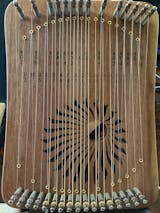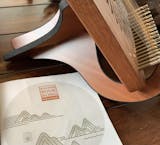Music has become an indispensable part of our lives in modern society. We use music to communicate, we use music to fall in love, and use music to spread beautiful sounds in this noisy and disturbing world.
And musical instruments, as a carrier of music, have a high rate of appearance in our lives. We have seen youthful college students on campus for a long time, humming ambiguous songs with guitar music as poems. In the community, in the park, the aunt who loves to dance square dancing and the uncle who pulls the erhu complement each other, whispering about the parents' shortcomings. In the boudoir, the sun rises from the east, and the crisp sound of reading aloud and piano music comes from afar, and begins to wake up the misty us in the morning. Musical instruments are everywhere in our lives.
Today, what I wants to share with you is a musical instrument that may not be so well-known to the public, the thumb piano, an aesthetic instrument that can heal the soul.
What kind of wood is used to make the thumb piano?
The appearance of an musical instrument is indispensable for the players of the musical instruments, but also the producers of the musical instruments. The production of musical instruments is almost magical in the eyes of some businessmen in TV dramas. But when it’s hand-made, the production process is far from as complicated as we imagined, but it’s actually not easy.
Among the popular thumb pianos on the market, black walnut, maple, and sapele are the most popular from the classification of the body. Next, I will introduce to you the advantages of these three woods.
Black walnut: Black walnut is not the origin of the tree in my country. The real origin is from the United States. Black walnut has the characteristics of resistance to impact and friction, resistance to decay, easy to dry, and less deformation; easy to construct and easy to glue. In terms of price, this tree species is relatively expensive, but the sound of the thumb piano using this wood has bright and clear mid-to-low tones, as well as excellent resonance and continuity.
Maple: The basic pattern of maple is beautiful, and the color of the logs is good. It is produced in North America, Europe, and Northern Africa. The tone color is beautiful and the log color is good. It is produced in North America, Europe, and Northern Africa. The mid-frequency of the tone is clear, the high-frequency is mild, and the resonance echo effect is moderate. The intermediate frequency is relatively clear, the high-frequency is mild, and the resonance echo effect is moderate. Maple has a higher appearance than other woods.
Sapele: In fact, Sapele has more important applications for the thumb piano in the market. It does not have any particular advantages, but it does not have too many shortcomings. And the coloring is relatively simple. In addition, Sapele has high color and good surface finish, and it is produced in Gabon, Congo and other places. The timbre is the same as the mahogany, the audio is relatively balanced, there is no prominent point, and the stability is not bad.
Today, I recommends to everyone the excellent black walnut thumb piano, which has a low and ethereal sound and a certain degree of stability. I hope everyone likes it.
Today’s knowledge about ethereal drums is shared with you. If you want to get more knowledge about Tongue Drums, Thumb Pianos Kalimba, and Handpan Drums, welcome to visit the official website of HLURU Musical Instruments and master your own music knowledge together.





